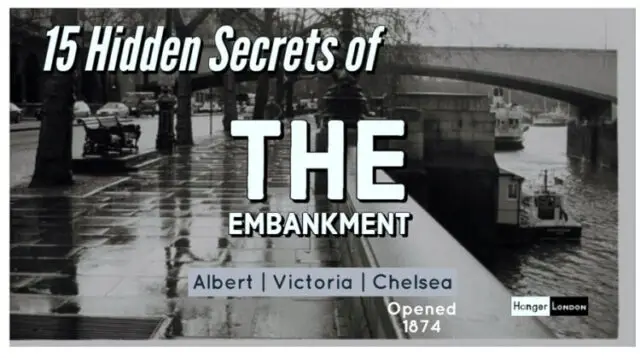On the 9th May 1874, Victoria Embankment opened to the public, nearly 150 years on, the area affectionally termed as the Embankment, looks as new as the day the granite-lined walls were dropped in place. What is the story behind one of the most recognisable riverfronts in the world?
The meaning of the word Embankment?
The word embankment refers to a wall of earth or stone that holds back a body of water from flooding an area. It also refers to a raised elevated structure that is used for any purpose to build on top of a road or railway. The word originates from the word embank “to close with a bank” 1766
The early period of the River Thames, River or Estuary?
Before the Romans, way way back, the river we know today was broad and unrestrained with sandy banks that stretched as far as the hills of Camberwell and Sydenham in the south and to Highgate and Hampstead in the north. At Low tide large sandy plains would form over time, presenting the challenge to early settlers that much of what would become modern London is actually below the waterline. The question is, was it really a river, even in Christopher Wren’s time, many consider the Thames originally was more of a estuary. Whatever it was, it became the River Thames through the work of early settlers and Roman engineers who built the embankments which over time began to form the shape of the river we see today.
Christopher Wren, the lost opportunity for one of the great riverfronts
Wren set out plans to build an elevated stone quay walkway that would stretch from the Tower of London to Blackfriars after the Great Fire of London. Before collecting your things and seeking to walk this great river frontage, The Government did not adopt Christopher Wren’s plan, so London missed out on a Wren-designed Embankment. Not only missing out on another Wren masterpiece but presenting a lost opportunity to develop what would surely have been one of the most iconic river frontages in the world.
Indeed there were many attempts to build open spaces over the years, that modern-day city planners could quite clearly see as great places for annual celebrations. That is London city planning over the centuries, interwoven by vested interest, politics, power, and money. In some sense, it does get there in the end, but we do have to acknowledge the great plans that got away.
Civil Engineer Sir J. W. Bazalgette the London Sewer and The Embankment
Sir Joseph William Bazalgette was a 19th-century civil engineer who gave London two projects, both of which remain standing today. One below the ground in the first London sewer network, which helped wipe out cholera, and above ground the most impressive Albert, Victoria, and Chelsea Embankments. The purpose of building the Embankment was to serve the public congestion problems and to house the sewage system being built.
The Embankment was originally a ramshackle of odd buildings, some expensive riverside dwellings, and broad undefined waterfront of marsh underfoot. The project spent £450,000 buying up the properties that lined the Embankment. They estimated the cost of the Build to stand at £1,260,000, using an approximate measure of inflation, in today’s money this could be £140 Million, Seem woefully small, the value of rebuilding that stretch today as a civil engineering project? would not even cover the free hold of a small dwelling.
Albert, Victoria, and Chelsea Embankments
The Embankment project in a 3 part section; they gave each section the names Albert, Victoria, and Chelsea. If you are familiar with London’s Embankment you would also be familiar with those names. The Queen by the side of her beloved husband to live on forever. The project was planned as a 3 piece of development, just take a moment to think of the planning, the workforce, and the organisation to complete this work in 1800s London. Consider a civil engineering project in recent times i.e. Docklands and then consider taking all the phones away from the workforce, computers, trucks, diggers, etc. Victorian engineering is something impressive to behold and admire.
The quarried stone comes from the Lamorna Cove quarry in Cornwall. The stones were cut and shaped on-site and then loaded onto barges up the English Channel, down the river Thames.
The Victoria Embankment section is 1 and 1/4 miles long, The Thames River was damned in 2 places to allow for the builders to build the foundations and wall. The formidable foundations of Portland concrete and granite wall go down 32 1/2 feet below the high water mark. The road above is 64 feet wide, which now contains a cycle superhighway.
Lions fit for Kings
On the top of the Embankment can be found Lions fit for kings, with huge mooring chain hoops. These lions were sculptured in 1868 by Timothy Butler. Not only do the Lions keep watch, but they also provide flood warnings to superstitious Londoners
“When the lions drink, London will sink”
Flood warning Rhyme
“When it’s up to their manes, we’ll go down the drains”
“When the water is sucked, you can be sure we’re all … in trouble”
The mooring rings, as far as records suggest are there for pure decorative purposes. The Lions can be seen from the river or from the opposite side of the bank. Do not lean over the wall dear visitor!
The Bomb damage against the Sphinx
Gotha Bomber dropped a 50kg bomb on the Embankment which exploded on the pavement next to the Sphinx and a passing tram. It killed the Tram driver and 2 passengers. The sphinx today still has the shrapnel damage from that ww1 bomb attack.
Other interesting London Embankment facts
- They built 2 Gardens as part of the project, which faces the back of Whitehall buildings.
- They buried a 19th Century time capsule under Cleopatra’s Needle. The contents of this, are British Currency, a Railway guide, 12 picture portraits, and the bible.
- Apparently, the Northern Line platform at Embankment Station is the only place on the network where you can hear the original recording of ‘Mind the Gap’. The announcer’s widow wrote a letter asking if they could play it, to hear his voice again. Comment below if you have recorded this unique recording.
- The embankment station has a hidden substation attached to it, why it is there will be in the next dispatches
Oil Painting of London Embankment at the Museum of London
This Oil painting illustrates the opening of the Victoria Embankment. We link this image from the London Museum website. Why not pop into the museum and have a look?











